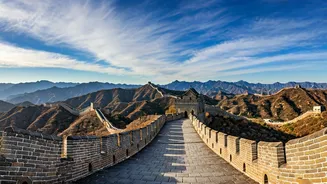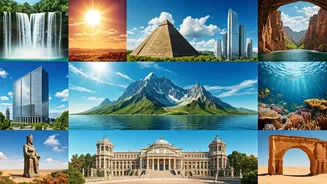Great Wall of China
Stretching thousands of miles, the Great Wall of China stands as a testament to human ingenuity and perseverance. Construction began during the Qin dynasty,
with later expansions adding to its magnitude. This colossal fortification served as a defensive barrier, but today, it symbolizes China's rich past. Visitors are captivated by its winding paths, watchtowers, and panoramic views. Walking along the wall offers not just a physical journey but also an immersion into the historical narratives of ancient China, providing a profound appreciation for its strategic significance and the dedication of its builders. The Great Wall showcases impressive feats of engineering, blending harmoniously with the varied landscape and evoking a deep sense of awe.
Petra, Jordan's Rose City
Hidden within the Jordanian desert, Petra is an ancient city carved into sandstone cliffs, renowned for its stunning architecture and intricate facades. This UNESCO World Heritage site was once a thriving trade center, populated by the Nabataean civilization. The Treasury and Monastery are the most celebrated structures. Petra's strategic location facilitated the exchange of goods and ideas, and its rock-cut structures showcase an understanding of architecture and design. The intricate details of the carvings, combined with the city's unique location, provide a memorable experience. The play of light and shadow across the rose-colored stone during the day adds to its charm, and the archaeological richness of Petra makes it an enduring symbol of history and human achievement.
Christ the Redeemer
Perched atop Corcovado Mountain in Rio de Janeiro, Brazil, Christ the Redeemer is an iconic statue that embraces the city with open arms. Completed in 1931, the statue stands as a symbol of peace and welcome. The statue's design combines art deco aesthetics with Christian symbolism, reflecting a fusion of cultural and religious influences. The statue's placement atop the mountain offers spectacular panoramic views, drawing visitors from around the world. Christ the Redeemer has become a symbol of Brazil, representing its spirit of hospitality and becoming an enduring testament to faith and architectural excellence. This monument continues to inspire and offers a sense of spiritual connection.
Machu Picchu, Peru
High in the Andes Mountains of Peru, Machu Picchu is an ancient Inca citadel that continues to amaze. Built in the 15th century, the site was rediscovered in 1911 and provides insights into the sophisticated civilization of the Incas. The stone structures, seamlessly integrated with the mountain terrain, showcase the Incas' remarkable architectural prowess. The precision of the stonework, the complex layout, and its location, contribute to Machu Picchu's status. The mystery surrounding its original purpose and the circumstances of its abandonment make it a place filled with fascination. This 'Lost City of the Incas' presents a glimpse into the past and remains a symbol of human adaptability and ingenuity, attracting millions of visitors who travel through rugged terrains to witness its grandeur.
Chichen Itza, Mexico
Chichen Itza in the Yucatan Peninsula of Mexico stands as a prominent archaeological site that reflects the cultural richness of the ancient Mayan civilization. This UNESCO World Heritage site is famous for its massive pyramid El Castillo, which embodies the Mayan calendar and astronomical knowledge. The site showcases a combination of Mayan and Toltec architectural styles, reflecting the dynamic history of the region. The intricate carvings, temples, and observatory demonstrate the advanced skills of the Mayan people in various domains. Visiting Chichen Itza is like walking through the chapters of history, providing a vibrant glimpse into the past and the legacy of the Maya. It is a symbol of their intellectual and artistic achievements.
Colosseum, Rome
The Colosseum in Rome is a historic amphitheater, built during the Roman Empire, and served as a venue for gladiatorial contests and public spectacles. Completed in 80 AD, the Colosseum could host tens of thousands of spectators, reflecting the power and entertainment of Roman society. Its innovative design, including an elaborate system of vaults and arches, showcases the Roman mastery of engineering. The Colosseum stands today as an iconic monument, witnessing centuries of history and stories. It reminds visitors of the glory and brutality of the Roman Empire, offering a deeper understanding of the past. As a symbol of Rome's enduring legacy, the Colosseum still captivates with its imposing presence and historical significance.
Taj Mahal, India
The Taj Mahal in Agra, India, is a majestic mausoleum constructed by Mughal emperor Shah Jahan to honor his wife Mumtaz Mahal. Built in the 17th century, the Taj Mahal is a tribute to eternal love. The gleaming white marble, intricate carvings, and symmetrical design exemplify the architectural magnificence of the Mughal era. The Taj Mahal is a combination of Persian, Islamic, and Indian architectural styles, representing a fusion of cultures. The monument is set on a sprawling complex, that includes gardens and reflecting pools. The Taj Mahal is a testament to love and an enduring icon of India. It continues to attract tourists and admirers, symbolizing eternal love, beauty, and architectural mastery.
The Pyramids of Giza
Located in Egypt, the Pyramids of Giza stand as iconic structures. The Great Pyramid of Giza, the largest of the three, was commissioned by the pharaoh Khufu, serving as a tomb. Built during the Old Kingdom period, these pyramids exemplify the advanced engineering of ancient Egyptians. The precision with which they were constructed, the alignment of the structures, and the scale of the undertaking highlight the civilization's capabilities. Along with the Sphinx, these pyramids form a unique cultural and historical complex. The Pyramids of Giza evoke the wonder of ancient Egypt and continue to inspire awe, representing the power and beliefs of its rulers and people. Their enduring presence highlights the ability of humans.
Ha Long Bay, Vietnam
Ha Long Bay in Vietnam is a UNESCO World Heritage site characterized by its emerald waters and thousands of limestone karsts. This stunning landscape features islands and caves, making it a beautiful destination. The unique geological formations, sculpted by natural processes, provide a captivating setting. The bay's natural beauty, enriched by its cultural significance, offers a blend of relaxation and exploration. Visitors can experience the breathtaking scenery through boat trips, kayaking, and exploration of caves. Ha Long Bay represents the natural wonders of Vietnam and draws tourists from around the world to marvel at its beauty. The natural harmony found in Ha Long Bay makes it a scenic wonder.











